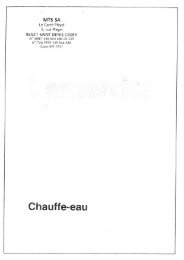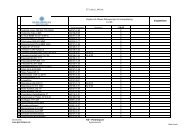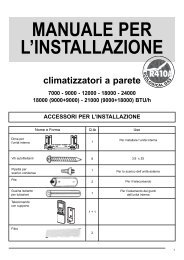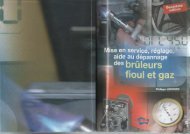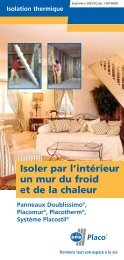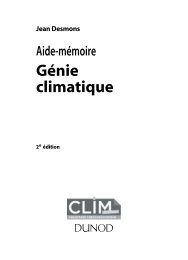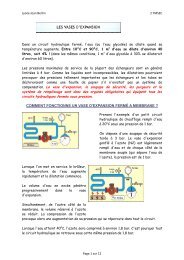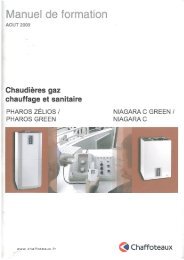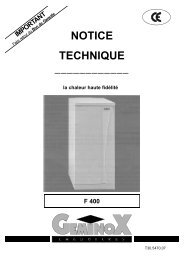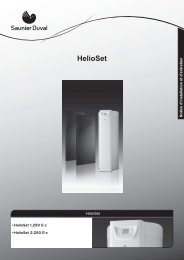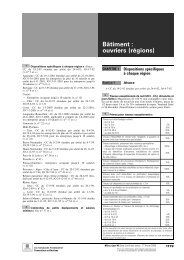Dimplex_LIH 22-26TE 3-sprachig D-GB-F.book - enrdd.com
Dimplex_LIH 22-26TE 3-sprachig D-GB-F.book - enrdd.com
Dimplex_LIH 22-26TE 3-sprachig D-GB-F.book - enrdd.com
Create successful ePaper yourself
Turn your PDF publications into a flip-book with our unique Google optimized e-Paper software.
6.4<br />
Antifreeze<br />
A method of manual drainage (see illustration) should be provided<br />
for heat pumps which are exposed to frost. The antifreeze<br />
function of the heat pump controller is active whenever the controller<br />
and the heat circulating pump are ready for operation. If<br />
the heat pump is taken out of service or in the event of a power<br />
failure, the system has to be drained. The heating circuit should<br />
be operated with a suitable antifreeze if heat pump systems are<br />
implemented in buildings where a power failure can not be detected<br />
(holiday home).<br />
7 Start-Up<br />
7.1 General Information<br />
To ensure that start-up is performed correctly, it should only be<br />
carried out by an after-sales service technician authorised by the<br />
manufacturer. This may be a condition for extending the guarantee<br />
(see Warranty Service).<br />
7.2 Preparation<br />
English<br />
6.4 Electrical Connection<br />
The power supply and control voltage are supplied using standard<br />
cables (load: 4-core, control: 3-core).<br />
An all-pole disconnecting device with a contact gap of at least<br />
3 mm (e.g. utility blocking contactor or power contactor) as well<br />
as a 3-pole circuit breaker with <strong>com</strong>mon tripping for all external<br />
conductors must be installed in the power supply (tripping current<br />
in <strong>com</strong>pliance with the Device Information).<br />
Ensure that the in<strong>com</strong>ing supply has a clockwise rotating field<br />
when connecting multiphase devices L1; L2; L3.<br />
ATTENTION!<br />
Ensure that there is a clockwise rotating field: Operating the<br />
<strong>com</strong>pressors in the wrong rotational direction could cause damage to the<br />
<strong>com</strong>pressors.<br />
The control voltage must be protected by a 10 A fuse.<br />
The heat pump controller has a 230 V AC-50 Hz power supply.<br />
Connect the controller in <strong>com</strong>pliance with its own operating instructions<br />
(16 A fuse).<br />
The preinstalled, 7-m long control line is connected to the heat<br />
pump controller using both rectangular plug connectors and single-core<br />
wires (integral return flow sensor). The heat pump controller<br />
is a mandatory part of the control system. More detailed information<br />
can be found in the operating instructions of the heat<br />
pump controller.<br />
For detailed information, see Circuit Diagrams in the Appendix.<br />
The following items need to be checked prior to start-up:<br />
• All of the heat pump connections must be established as described<br />
in Chapter 6.<br />
• All valves that could impair the proper flow of the heating<br />
water in the heating circuit must be open.<br />
• The air intake and air outlet paths must be clear.<br />
• The ventilator must turn in the direction indicated by the arrow.<br />
• The settings of the heat pump controller must be adapted to<br />
the heating system in accordance with the controller’s operating<br />
instructions.<br />
• Ensure the condensate outflow functions properly.<br />
7.3 Procedure<br />
The heat pump is started up via the heat pump controller. Adjustments<br />
should be made in <strong>com</strong>pliance with the instructions.<br />
If an overflow valve is fitted to maintain the minimum heating<br />
water flow rate, the valve must be adapted to the requirements of<br />
the heating system. Incorrect adjustment can lead to faulty operation<br />
and increased energy consumption. We re<strong>com</strong>mend carrying<br />
out the following procedure to correctly adjust the overflow<br />
valve:<br />
Close all of the heating circuits that may also be closed during<br />
operation (depending on the type of heat pump usage) so that<br />
the most unfavourable operating state - with respect to the water<br />
flow rate - is achieved. This normally means the heating circuits<br />
of the rooms on the south and west sides of the building. At least<br />
one heating circuit must remain open (e.g. bathroom).<br />
The overflow valve should be opened far enough to produce the<br />
maximum temperature spread between the heating flow and return<br />
flow listed in the following table for the current heat source<br />
temperature. The temperature spread should be measured as<br />
close as possible to the heat pump. The heating element of mono<br />
energy systems should be disconnected.<br />
Heat source<br />
temperature<br />
From To<br />
Max. temperature spread<br />
between heating flow and return<br />
flow<br />
-20 °C -15 °C 4 K<br />
-14 °C -10 °C 5 K<br />
-9 °C -5 °C 6 K<br />
-4 °C 0 °C 7 K<br />
1 °C 5 °C 8 K<br />
6 °C 10 °C 9 K<br />
11 °C 15 °C 10 K<br />
16 °C 20 °C 11 K<br />
21 °C 25 °C 12 K<br />
26 °C 30 °C 13 K<br />
31 °C 35 °C 14 K<br />
E-6



